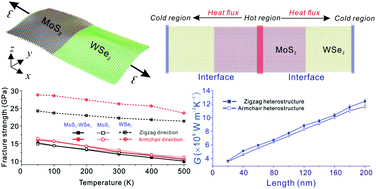The mechanical and thermal properties of MoS2–WSe2 lateral heterostructures
Abstract
The recently fabricated monolayer MoS2–WSe2 lateral heterostructures are promising for many interesting applications, such as p–n diodes, photodetectors, transistors, sensors, light-emitting diodes and thermoelectric and flexible nanodevices. In this work, we study the mechanical and thermal properties of MoS2–WSe2 lateral heterostructures by using molecular dynamics (MD) simulations based on the recently parameterized Stillinger-Weber (SW) potential. It is found that the fracture strength and fracture strain of MoS2–WSe2 lateral heterostructures are dictated by the mechanical properties of MoS2, and are very sensitive to temperature. However, when a crack is introduced in the MoS2–WSe2 heterostructures, failure may occur either in MoS2 or WSe2, depending on the crack length and location. Interestingly, the fracture strengths obtained from our MD simulations are in agreement with those obtained from the Griffith theory. Our MD simulations further reveal that, in addition to the low thermal conductivities of MoS2 and WSe2, the MoS2–WSe2 heterojunctions exhibit a very low interfacial thermal conductance, which is about one order of magnitude lower than that of graphene–hBN heterojunctions.



 Please wait while we load your content...
Please wait while we load your content...